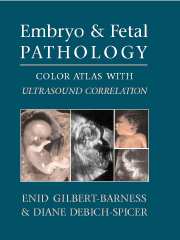Book contents
- Frontmatter
- Contents
- Foreword by John M. Opitz
- Preface
- Acknowledgments
- 1 The Human Embryo and Embryonic Growth Disorganization
- 2 Late Fetal Death, Stillbirth, and Neonatal Death
- 3 Fetal Autopsy
- 4 Ultrasound of Embryo and Fetus: General Principles
- 5 Abnormalities of Placenta
- 6 Chromosomal Abnormalities in the Embryo and Fetus
- 7 Terminology of Errors of Morphogenesis
- 8 Malformation Syndromes
- 9 Dysplasias
- 10 Disruptions and Amnion Rupture Sequence
- 11 Intrauterine Growth Retardation
- 12 Fetal Hydrops and Cystic Hygroma
- 13 Central Nervous System Defects
- 14 Craniofacial Defects
- 15 Skeletal Abnormalities
- 16 Cardiovascular System Defects
- 17 Respiratory System
- 18 Gastrointestinal Tract and Liver
- 19 Genito-Urinary System
- 20 Congenital Tumors
- 21 Fetal and Neonatal Skin Disorders
- 22 Intrauterine Infection
- 23 Multiple Gestations and Conjoined Twins
- 24 Metabolic Diseases
- Appendices
- Index
16 - Cardiovascular System Defects
Published online by Cambridge University Press: 23 February 2010
- Frontmatter
- Contents
- Foreword by John M. Opitz
- Preface
- Acknowledgments
- 1 The Human Embryo and Embryonic Growth Disorganization
- 2 Late Fetal Death, Stillbirth, and Neonatal Death
- 3 Fetal Autopsy
- 4 Ultrasound of Embryo and Fetus: General Principles
- 5 Abnormalities of Placenta
- 6 Chromosomal Abnormalities in the Embryo and Fetus
- 7 Terminology of Errors of Morphogenesis
- 8 Malformation Syndromes
- 9 Dysplasias
- 10 Disruptions and Amnion Rupture Sequence
- 11 Intrauterine Growth Retardation
- 12 Fetal Hydrops and Cystic Hygroma
- 13 Central Nervous System Defects
- 14 Craniofacial Defects
- 15 Skeletal Abnormalities
- 16 Cardiovascular System Defects
- 17 Respiratory System
- 18 Gastrointestinal Tract and Liver
- 19 Genito-Urinary System
- 20 Congenital Tumors
- 21 Fetal and Neonatal Skin Disorders
- 22 Intrauterine Infection
- 23 Multiple Gestations and Conjoined Twins
- 24 Metabolic Diseases
- Appendices
- Index
Summary
PRENATAL DIAGNOSIS
With the advent of ultrasound and its application to the human fetal heart,prenatal diagnosis and management of structural heart disease and cardiacdysrhythmia is possible (Figure 16.1). Congenital heart disease is relatively uncommonin the general population, and not every pregnancy can or should be examined with fetal echocardiography. Only those pregnancies with recognized risk factors for cardiac disease and those with an abnormal four-chamberview on level I obstetrical sonograms should be evaluated.
TECHNIQUE OF FETAL ECHOCARDIOGRAPHY
The fetal heart is most easily examined by ultrasound transabdominally at 18-24 weeks gestation, when a nonfixed fetal position, incompletely calcifiedbones, and abundant amniotic fluid make cardiac imaging easier (Table 16.1). Transvaginal images show excellent cardiac detail as early as 14 weeks gestation. Transvaginal imaging is invasive, however, and carries a small potential risk, it should be used when transabdominal imaging is inadequate. Transabdominal ultrasound uses a relatively high-frequency transducer to examine the heart and great vessels segmentally. It uses M-mode, two-dimensional, pulsewave, and color flow Doppler to delineate the cardiac anatomy, fetal hemodynamics, and patency of the fetal circulatory pathways. Anormal fetal echocardiogram does not eliminate the potential for congenital heart disease. Lesions that may not be identified prenatally include mild semilunar valve obstruction, atrial septal defect, small ventricular defect, and partial anomalous venous return. In addition, coarctation of the aorta is a significant lesion that is difficult to diagnose.
The early fetal heart can be dissected under a dissecting microscope in the same manner as the heart of anolder fetus or a newborn (illustrated in Chapter 3).
- Type
- Chapter
- Information
- Embryo and Fetal PathologyColor Atlas with Ultrasound Correlation, pp. 428 - 469Publisher: Cambridge University PressPrint publication year: 2004
- 1
- Cited by

